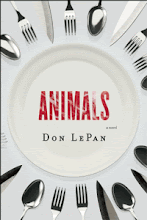* * *
The ScotiaBank and BCSPCA Paws for a Cause Walk to Fight Animal Cruelty is a great way of raising funds, as well as raising awareness of the importance of taking a stand against cruelty towards non-human animals.
But let’s not restrict our compassion for our fellow creatures to dogs and cats. The average North American is complicit in the cruel treatment of over a thousand individual animals over the course of his or her lifetime; for each North American every year, well over two dozen birds and mammals are cruelly treated in factory farms before being slaughtered. The advertising campaigns of the companies who are responsible for breeding, raising, and slaughtering these animals either make no mention of the conditions the animals are subjected to, or suggest that they are raised in the way that farm animals were generally raised until the 1960s—in natural conditions, with lots of time spent out of doors and lots of room to move around; without breeding programs that make animals heavier and less comfortable in order to produce meat and dairy products in greater volume at less cost; without regular doses of antibiotics and growth hormones; and with a great deal of compassion.
That’s still the way farm animals are raised in much of Europe. But it hasn’t been the way most pigs or chickens or turkeys or dairy cows or beef cattle have been raised in Canada or the United States for a very, very long time. Well over ninety-five percent of the animal products in most North American supermarkets are products of the cruelties of modern “intensive” farming. The cruelty involved is surely reason enough to take a stand against these products. But it’s worth knowing that they’re also bad for the environment—and that they’re bad for human health. (If you don’t yet know how animals are turned into these products, information is available on sites such as humanesociety.org, mercyforanimals.org, cetfa.org, and ciwf.com; in films such as Food Inc.; or in books such as Eating Animals. If you’d like to know more about what the products do for human health, information is available on sites such as nutritionfacts.org.)
How can we fight the cruelties of factory farming?
Go vegan. This is by far the best way to be sure you are not complicit in the cruelties of factory farming. (More and more studies are also suggesting that a whole foods vegan diet is best for promoting the health and the happiness of humans.)
Go free-range: insist on only free-range meat, eggs, and dairy products when you are shopping, and when you are eating in restaurants. Free-range products are far from perfect, but on average they are produced with considerably less cruelty than are “conventionally farmed” products. (In many areas of British Columbia you can also buy directly from local farmers, many of whom use only humane methods of raising animals.)
Go dairy-free. Many people imagine that dairy farming is the least cruel way of producing food for humans from the bodies of non-human animals. “We just take some of the milk away from the cow,“ people think; “where’s the harm in that?” Where to start when it comes to describing the harm? Perhaps with the fact that most dairy cows in North America live their entire lives in a small area of concrete—they never see a green pasture. Perhaps with the breeding of the modern dairy cow, which has been done so that the udder will always produce lots of milk inexpensively—and be horribly uncomfortable for the animal. Or perhaps with the most uncomfortable fact about all dairy farming: the milk is only available for human consumption because the cow’s babies have been taken away from her.





No comments:
Post a Comment
Comments welcome!